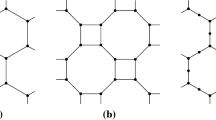Abstract
The 2D Discrete Gaussian model gives each height function \({\eta : {\mathbb{Z}^2\to\mathbb{Z}}}\) a probability proportional to \({\exp(-\beta \mathcal{H}(\eta))}\), where \({\beta}\) is the inverse-temperature and \({\mathcal{H}(\eta) = \sum_{x\sim y}(\eta_x-\eta_y)^2}\) sums over nearest-neighbor bonds. We consider the model at large fixed \({\beta}\), where it is flat unlike its continuous analog (the Discrete Gaussian Free Field). We first establish that the maximum height in an \({L\times L}\) box with 0 boundary conditions concentrates on two integers M, M + 1 with \({M\sim \sqrt{(1/2\pi\beta)\log L\log\log L}}\). The key is a large deviation estimate for the height at the origin in \({\mathbb{Z}^{2}}\), dominated by “harmonic pinnacles”, integer approximations of a harmonic variational problem. Second, in this model conditioned on \({\eta\geq 0}\) (a floor), the average height rises, and in fact the height of almost all sites concentrates on levels H, H + 1 where \({H\sim M/\sqrt{2}}\). This in particular pins down the asymptotics, and corrects the order, in results of Bricmont et al. (J. Stat. Phys. 42(5–6):743–798, 1986), where it was argued that the maximum and the height of the surface above a floor are both of order \({\sqrt{\log L}}\). Finally, our methods extend to other classical surface models (e.g., restricted SOS), featuring connections to p-harmonic analysis and alternating sign matrices.
Similar content being viewed by others
References
Abraham D.B. : Surface structures and phase transitions—exact results. In: Domb, C., Lebowitz, J.L. (eds) Phase Transitions and Critical Phenomena, pp. 1–74. Academic Press, UK (1986)
Bolthausen E., Deuschel J-D., Giacomin G.: Entropic repulsion and the maximum of the two-dimensional harmonic crystal. Ann. Probab. 29(4), 1670–1692 (2001)
Bolthausen E., Deuschel J.D., Zeitouni O.: Entropic repulsion of the lattice free field. Commun. Math. Phys. 170(2), 417–443 (1995)
Brandenberger R., Wayne C.E.: Decay of correlations in surface models. J. Stat. Phys. 27(3), 425–440 (1982)
Bricmont J., Fontaine J.-R., Lebowitz J.L.: Surface tension, percolation, and roughening. J. Stat. Phys. 29(2), 193–203 (1982)
Bricmont J., El Mellouki A., Fröhlich J.: Random surfaces in statistical mechanics: roughening, rounding, wetting. J. Stat. Phys. 42(5-6), 743–798 (1986)
Caputo P., Lubetzky E., Martinelli F., Sly A., Toninelli F.L.: Dynamics of 2 + 1 dimensional SOS surfaces above a wall: slow mixing induced by entropic repulsion. Ann. Probab. 42(4), 1516–1589 (2014)
Caputo, P., Lubetzky, E., Martinelli, F., Sly, A., Toninelli, F.L.: Scaling limit and cube-root fluctuations in SOS surfaces above a wall. J. Eur. Math. Soc. (JEMS) (to appear)
Caputo P., Lubetzky E., Martinelli F., Sly A., Toninelli F.L.: The shape of the (2 + 1)-dimensional SOS surface above a wall. C. R. Math. Acad. Sci. Paris 350, 703–706 (2012)
Chui S.T., Weeks J.D.: Phase transition in the two-dimensional Coulomb gas, and the interfacial roughening transition. Phys. Rev. B 14(11), 4978–4982 (1976)
Dobrushin, R., Kotecký, R., Shlosman, S.: Wulff construction. A global shape from local interaction. In: Translations of Mathematical Monographs, vol. 104. American Mathematical Society, Providence (1992)
Fortuin C.M., Kasteleyn P.W., Ginibre J.: Correlation inequalities on some partially ordered sets. Commun. Math. Phys. 22, 89–103 (1971)
Fröhlich J., Spencer T.: Kosterlitz–Thouless transition in the two-dimensional plane rotator and Coulomb gas. Phys. Rev. Lett. 46(15), 1006–1009 (1981)
Fröhlich J., Spencer T.: The Kosterlitz–Thouless transition in two-dimensional abelian spin systems and the Coulomb gas. Commun. Math. Phys. 81(4), 527–602 (1981)
Fröhlich J., Spencer T.: The Berežinskiĭ–Kosterlitz–Thouless transition (energy-entropy arguments and renormalization in defect gases), Scaling and self-similarity in physics. Progr. Phys. 7, 29–138 (1983)
Gallavotti, G., Martin-Löf, A., Miracle-Solé, S.: Some problems connected with the description of coexisting phases at low temperatures in the Ising model. In: Lenard, A. (ed.) Statistical Mechanics and Mathematical Problems, Lecture Notes in Physics, vol. 20, pp. 162–204. Springer, Berlin (1973)
Kuperberg G.: Another proof of the alternating-sign matrix conjecture. Internat. Math. Res. Not. 3, 139–150 (1996)
Lawler, G.F.: Intersections of random walks. In: Probability and its Applications, p. 219. Birkhäuser Boston Inc., Boston (1991)
Lawler, G.F., Limic, V.: Random walk: a modern introduction. In: Cambridge Studies in Advanced Mathematics, vol. 123. Cambridge University Press, Cambridge (2010), MR2677157 (2012a:60132)
Lyons, R., Peres, Y.: Probability on Trees and Networks. Cambridge University Press, Cambridge (2016). http://mypage.iu.edu/~rdlyons/prbtree/book (To appear)
Peled, R.: High-dimensional lipschitz functions are typically flat. Ann. Probab. (to appear)
Sinaĭ, Ya.G.: Theory of phase transitions: rigorous results. In: International Series in Natural Philosophy, vol. 108. Pergamon Press, Oxford (1982)
Soardi P.M.: Potential Theory on Infinite Networks. Springer, Berlin (1994)
Swendsen R.H.: Monte Carlo study of the Coulomb gas and the Villain XY model in the discrete Gaussian roughening representation. Phys. Rev. B 18(1), 492 (1978)
Villain J.: Theory of one-and two-dimensional magnets with an easy magnetization plane. II. The planar, classical, two-dimensional magnet. J. Physique 36(6), 581–590 (1975)
Weeks, J.D.: The roughening transition. Riste, T.(ed.) Ordering in Strongly Fluctuating Condensed Matter Systems, vol. 474, pp. 293–317. Springer, Berlin (1980)
Weeks J.D., Gilmer G.H.: Dynamics of crystal growth. Adv. Chem. Phys. 40(489), 157–227 (1979)
Zeilberger, D.: Proof of the alternating sign matrix conjecture. The Foata Festschrift. Electron. J. Combin. 3(2), (1996) Research Paper 13, approx. 84 pp. (electronic)
Author information
Authors and Affiliations
Corresponding author
Additional information
Communicated by F. Toninelli
Rights and permissions
About this article
Cite this article
Lubetzky, E., Martinelli, F. & Sly, A. Harmonic Pinnacles in the Discrete Gaussian Model. Commun. Math. Phys. 344, 673–717 (2016). https://doi.org/10.1007/s00220-016-2628-5
Received:
Accepted:
Published:
Issue Date:
DOI: https://doi.org/10.1007/s00220-016-2628-5




